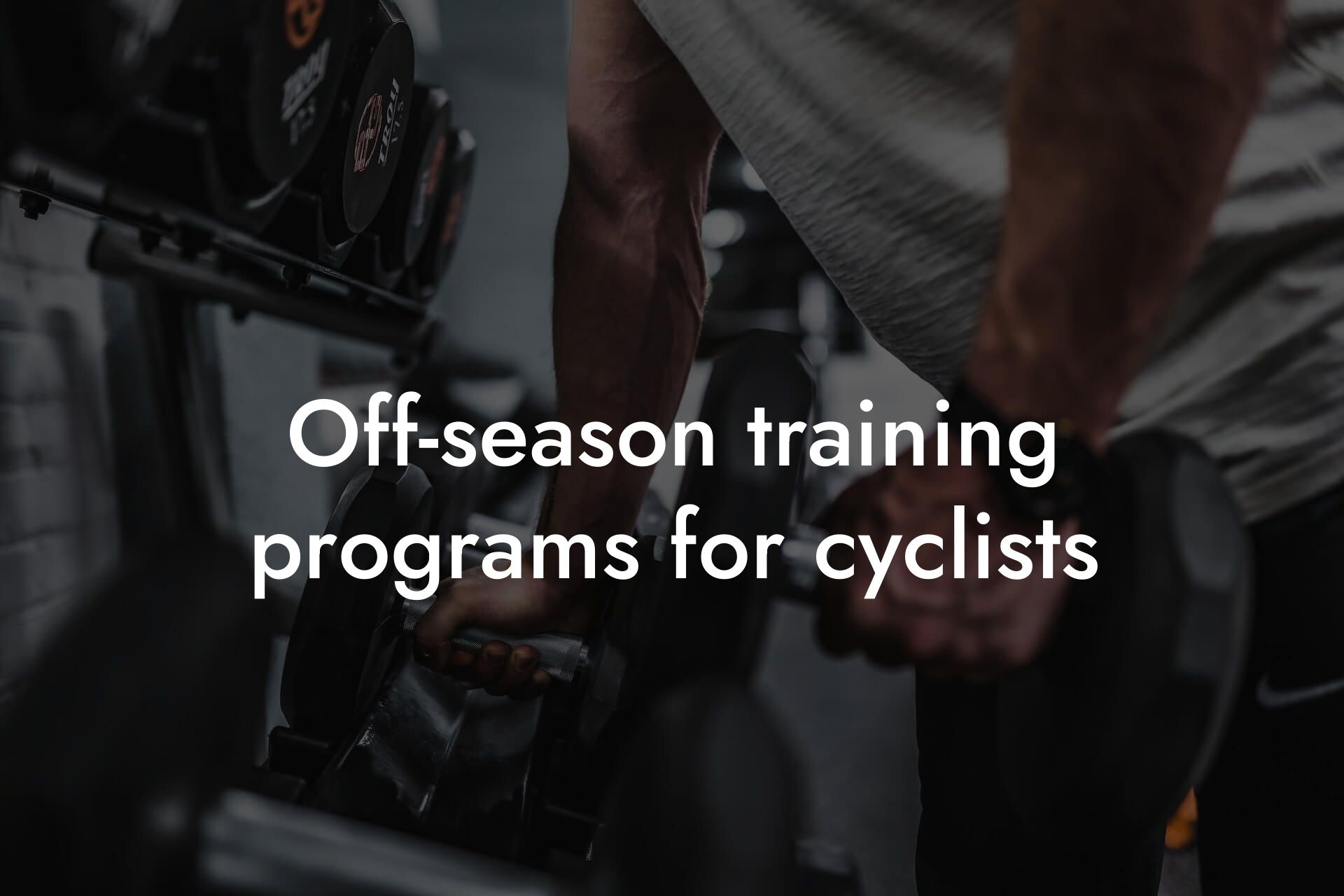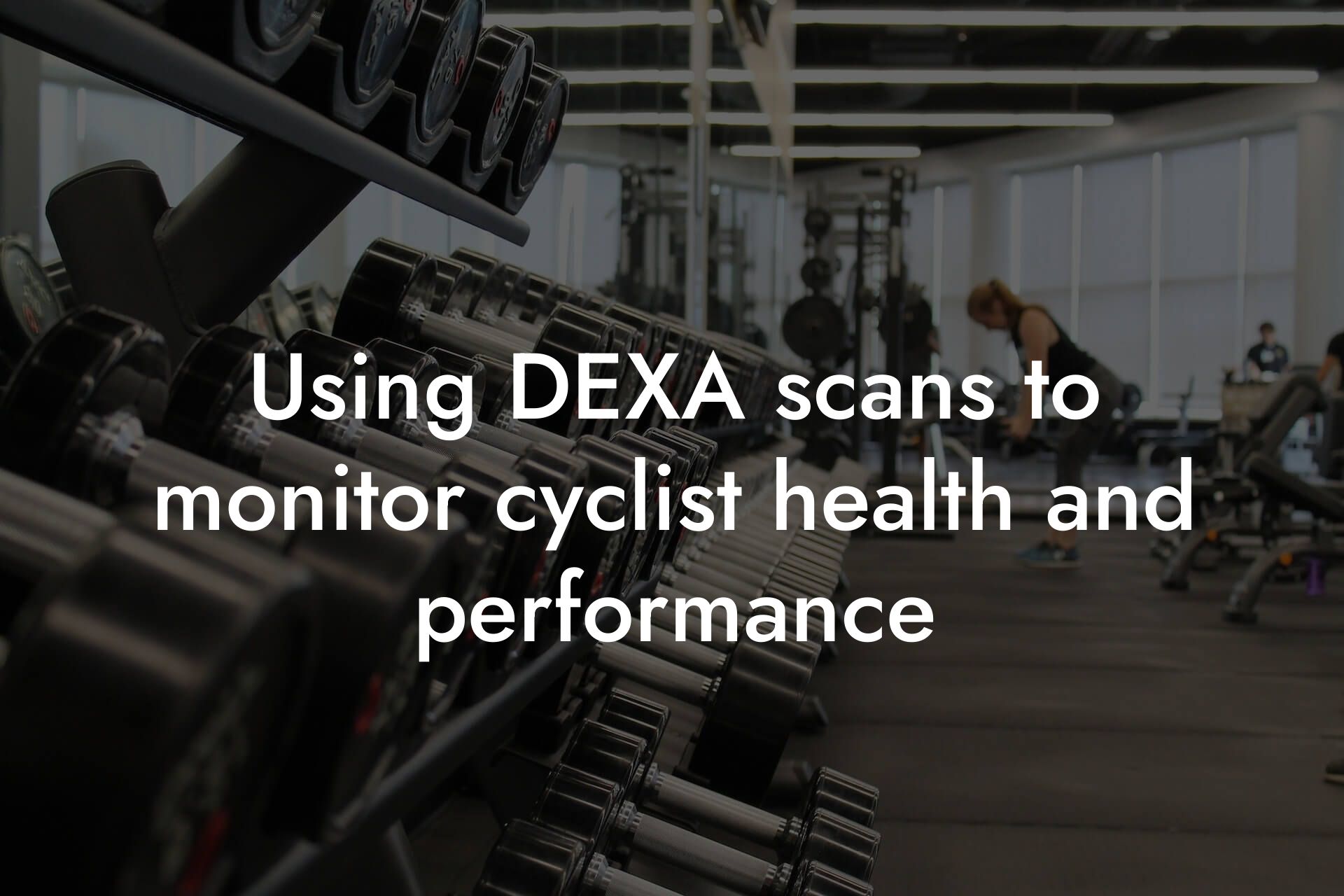As a high-earning professional, you understand the importance of maintaining a healthy and fit physique. Cycling is an excellent way to improve cardiovascular health, build endurance, and boost overall physical fitness. However, many cyclists overlook the critical role that muscle mass plays in cycling endurance. In this article, we'll delve into the significance of muscle mass in cycling and provide you with valuable insights to take your cycling performance to the next level.
Table of Contents
- What is Muscle Mass?
- Why is Muscle Mass Important for Cycling Endurance?
- The Science Behind Muscle Mass and Cycling Endurance
- How to Build Muscle Mass for Cycling Endurance
- Common Misconceptions About Muscle Mass and Cycling Endurance
- How DEXA Scans Can Help You Optimize Your Muscle Mass for Cycling Endurance
- Frequently Asked Questions
What is Muscle Mass?
Muscle mass refers to the amount of muscle tissue in your body. It's a critical component of overall health and fitness, as it plays a vital role in movement, metabolism, and overall physical function. In cycling, muscle mass is particularly important, as it directly affects your power output, endurance, and overall performance.
Why is Muscle Mass Important for Cycling Endurance?
Muscle mass is essential for cycling endurance because it enables you to generate power and sustain it over a prolonged period. The more muscle mass you have, the more efficient your body becomes at producing energy and maintaining speed. This is because muscle fibers are responsible for generating force and propulsion during cycling. The greater the muscle mass, the greater the force and propulsion, resulting in improved cycling endurance.
The Science Behind Muscle Mass and Cycling Endurance
Research has shown that muscle mass is closely linked to cycling endurance. A study published in the Journal of Strength and Conditioning Research found that cyclists with higher muscle mass had improved cycling economy and endurance compared to those with lower muscle mass. This is because muscle mass is directly related to the number of mitochondria in muscle fibers, which are responsible for generating energy during exercise.
How to Build Muscle Mass for Cycling Endurance
Building muscle mass for cycling endurance requires a combination of proper nutrition, training, and recovery. Here are some tips to help you build muscle mass and improve your cycling performance:
• Incorporate strength training: Focus on exercises that target your legs, glutes, and core, such as squats, lunges, and deadlifts.
• Eat enough protein: Aim to consume 1.2-1.6 grams of protein per kilogram of body weight daily to support muscle growth and repair.
• Incorporate high-intensity interval training (HIIT): HIIT involves short bursts of high-intensity exercise followed by brief periods of rest. This type of training is effective for building muscle mass and improving cycling endurance.
• Get enough rest and recovery: Adequate rest and recovery are critical for muscle growth and repair. Ensure you get 7-9 hours of sleep daily and take rest days as needed.
Common Misconceptions About Muscle Mass and Cycling Endurance
There are several misconceptions about muscle mass and cycling endurance that can hinder your progress. Here are some common myths debunked:
• Myth: Building muscle mass will make me slower and less efficient on the bike.
Reality: While it's true that excess muscle mass can increase your overall weight, it's also true that muscle mass is essential for generating power and propulsion during cycling. A well-balanced training program that incorporates strength training and cycling-specific exercises can help you build functional muscle mass that improves your cycling performance.
• Myth: I don't need to worry about muscle mass because I'm already lean and fit.
Reality: While being lean and fit is important for cycling performance, it's not a guarantee of optimal muscle mass. Even lean individuals can have low muscle mass, which can negatively impact their cycling endurance. Regular strength training and proper nutrition can help ensure you have adequate muscle mass to support your cycling goals.
How DEXA Scans Can Help You Optimize Your Muscle Mass for Cycling Endurance
At Tano Performance Group, we understand the importance of accurate body composition analysis for optimizing muscle mass and cycling performance. Our state-of-the-art DEXA scans provide a comprehensive assessment of your body composition, including muscle mass, bone density, and body fat percentage. With this information, you can:
• Identify areas for improvement: DEXA scans help you pinpoint areas where you may need to focus on building muscle mass or reducing body fat.
• Track progress: Regular DEXA scans enable you to monitor changes in your body composition over time, ensuring you're on track to meet your cycling goals.
• Optimize training and nutrition: With accurate body composition data, you can tailor your training and nutrition programs to support muscle growth and repair, leading to improved cycling performance.
In conclusion, muscle mass plays a critical role in cycling endurance. By understanding the importance of muscle mass, incorporating strength training and proper nutrition into your regimen, and leveraging the power of DEXA scans, you can optimize your body composition and take your cycling performance to the next level. Remember, at Tano Performance Group, we're committed to helping high-earning professionals like you achieve their fitness goals and maintain a healthy, fit physique.
Frequently Asked Questions
What is the importance of muscle mass in cycling endurance?
Muscle mass plays a crucial role in cycling endurance as it directly affects a cyclist's power output, speed, and overall performance. Having adequate muscle mass helps cyclists to maintain a high pace over a longer period, making them more efficient and effective on the road or track.
How does muscle mass impact cycling performance?
Muscle mass has a significant impact on cycling performance by increasing power output, speed, and endurance. It also helps to reduce fatigue, allowing cyclists to maintain a high intensity over a longer period. Additionally, muscle mass helps to improve pedaling efficiency, making every pedal stroke more effective.
What are the key muscle groups involved in cycling?
The key muscle groups involved in cycling are the quadriceps, hamstrings, glutes, calves, and core muscles. These muscles work together to generate power, speed, and efficiency on the bike.
How can I increase my muscle mass for cycling?
To increase muscle mass for cycling, focus on a combination of strength training exercises, such as squats, lunges, and deadlifts, and high-intensity interval training (HIIT) on the bike. Additionally, ensure you're consuming adequate protein to support muscle growth and recovery.
What is the optimal muscle mass for cycling endurance?
The optimal muscle mass for cycling endurance varies depending on the individual and their specific goals. However, a general guideline is to aim for a lean body mass of 10-15% above your ideal body weight.
How does body fat percentage affect cycling performance?
Body fat percentage has a significant impact on cycling performance, as excess body fat can increase energy expenditure and reduce power output. Aim for a body fat percentage of 10-15% for optimal cycling performance.
Can I build muscle mass and lose body fat at the same time?
Yes, it is possible to build muscle mass and lose body fat simultaneously. This requires a combination of proper nutrition, strength training, and high-intensity interval training. Focus on consuming adequate protein, complex carbohydrates, and healthy fats, while also getting enough rest and recovery.
How does muscle mass affect bone density in cyclists?
Muscle mass has a positive impact on bone density in cyclists, as it helps to increase the load on bones, stimulating bone growth and density. This is especially important for cyclists, as they are at risk of osteoporosis due to the low-impact nature of the sport.
What are the benefits of strength training for cyclists?
Strength training provides numerous benefits for cyclists, including increased power output, speed, and endurance. It also helps to reduce the risk of injury, improve pedaling efficiency, and enhance overall cycling performance.
How often should I strength train as a cyclist?
Aim to strength train 2-3 times per week, focusing on exercises that target the key muscle groups involved in cycling. This will help to improve power output, speed, and endurance, while also reducing the risk of injury.
What are the best strength training exercises for cyclists?
The best strength training exercises for cyclists include squats, lunges, deadlifts, leg press, and step-ups. These exercises target the quadriceps, hamstrings, glutes, and core muscles, which are essential for generating power and speed on the bike.
How does nutrition impact muscle mass and cycling performance?
Nutrition plays a critical role in muscle mass and cycling performance. Focus on consuming adequate protein, complex carbohydrates, and healthy fats to support muscle growth and recovery. Additionally, ensure you're staying hydrated by drinking plenty of water before, during, and after rides.
What are the best foods for building muscle mass and cycling performance?
The best foods for building muscle mass and cycling performance include lean proteins such as chicken, fish, and eggs, complex carbohydrates like brown rice, quinoa, and whole grain bread, and healthy fats like nuts, seeds, and avocados.
How does rest and recovery impact muscle mass and cycling performance?
Rest and recovery are critical components of building muscle mass and improving cycling performance. Ensure you're getting 7-9 hours of sleep per night and taking rest days as needed to allow your body to recover and adapt.
Can I still build muscle mass and improve cycling performance as I age?
Yes, it is still possible to build muscle mass and improve cycling performance as you age. However, it may require more patience, dedication, and attention to nutrition and recovery. Focus on making gradual changes to your training and nutrition plan, and be patient with your progress.
How does muscle imbalances affect cycling performance?
Muscle imbalances can have a significant impact on cycling performance, as they can lead to poor pedaling efficiency, reduced power output, and increased risk of injury. Focus on identifying and addressing any muscle imbalances through strength training and stretching exercises.
What are the common muscle imbalances in cyclists?
The common muscle imbalances in cyclists include weak glutes, tight hip flexors, and overdeveloped quadriceps. These imbalances can lead to poor pedaling efficiency, reduced power output, and increased risk of injury.
How can I prevent muscle cramps during cycling?
Muscle cramps can be prevented during cycling by ensuring you're staying hydrated, consuming adequate electrolytes, and incorporating stretching and foam rolling into your training routine.
What are the benefits of incorporating strength training into my cycling routine?
Incorporating strength training into your cycling routine provides numerous benefits, including increased power output, speed, and endurance, as well as reduced risk of injury and improved overall cycling performance.
How does cycling-specific strength training differ from traditional strength training?
Cycling-specific strength training differs from traditional strength training in that it focuses on exercises that target the specific muscle groups used in cycling, such as the quadriceps, hamstrings, and glutes. This helps to improve pedaling efficiency, power output, and overall cycling performance.
Can I still improve my cycling performance without strength training?
Yes, it is still possible to improve your cycling performance without strength training. However, incorporating strength training into your routine can provide an additional boost to your performance, helping you to reach your goals faster and more efficiently.
How does muscle mass impact cycling economy?
Muscle mass has a significant impact on cycling economy, as it directly affects a cyclist's power output, speed, and endurance. Having adequate muscle mass helps cyclists to maintain a high pace over a longer period, making them more efficient and effective on the road or track.
What are the long-term benefits of building muscle mass for cycling?
The long-term benefits of building muscle mass for cycling include improved overall health, increased bone density, and enhanced athletic performance. Additionally, building muscle mass can help to reduce the risk of injury and improve overall cycling efficiency.
Here are some related articles you might love...
- Off-season training programs for cyclists
- Bone density and injury prevention for cyclists
- Using DEXA scans to monitor cyclist health and performance
- Recovery strategies for cyclists after intense races
- Nutrition tips for endurance during long cycling races
- Strength training for cyclists to improve power output
- The importance of body composition in cycling performance
- Reducing body fat for better power-to-weight ratio in cycling
- Hydration and nutrition for optimal cycling performance
Zak Faulkner
Zak Faulkner is a leading authority in the realm of physical health and body composition analysis, with over 15 years of experience helping professionals optimise their fitness and well-being. As one the experts behind Tano Performance Group, Zak has dedicated his career to providing in-depth, science-backed insights that empower clients to elevate their physical performance and overall health.
With extensive knowledge of DEXA technology, Zak specializes in delivering comprehensive body assessments that offer precise data on body fat, muscle mass, bone density, and overall physique. His expertise enables individuals to make informed decisions and achieve their fitness goals with accuracy and confidence. Zak’s approach is rooted in a deep understanding of human physiology, combined with a passion for helping clients unlock their full potential through personalised strategies.
Over the years, Zak has earned a reputation for his commitment to excellence, precision, and client-focused service. His guidance is trusted by top professionals who demand the best when it comes to their health. Whether advising on fitness programs, nutritional strategies, or long-term wellness plans, Zak Faulkner’s insights are a valuable resource for anyone serious about taking their health and fitness to the next level.
At Tano Performance Group, Zak continues to lead our Content Team revolutionising how professionals approach their physical health, offering unparalleled expertise that drives real results.




